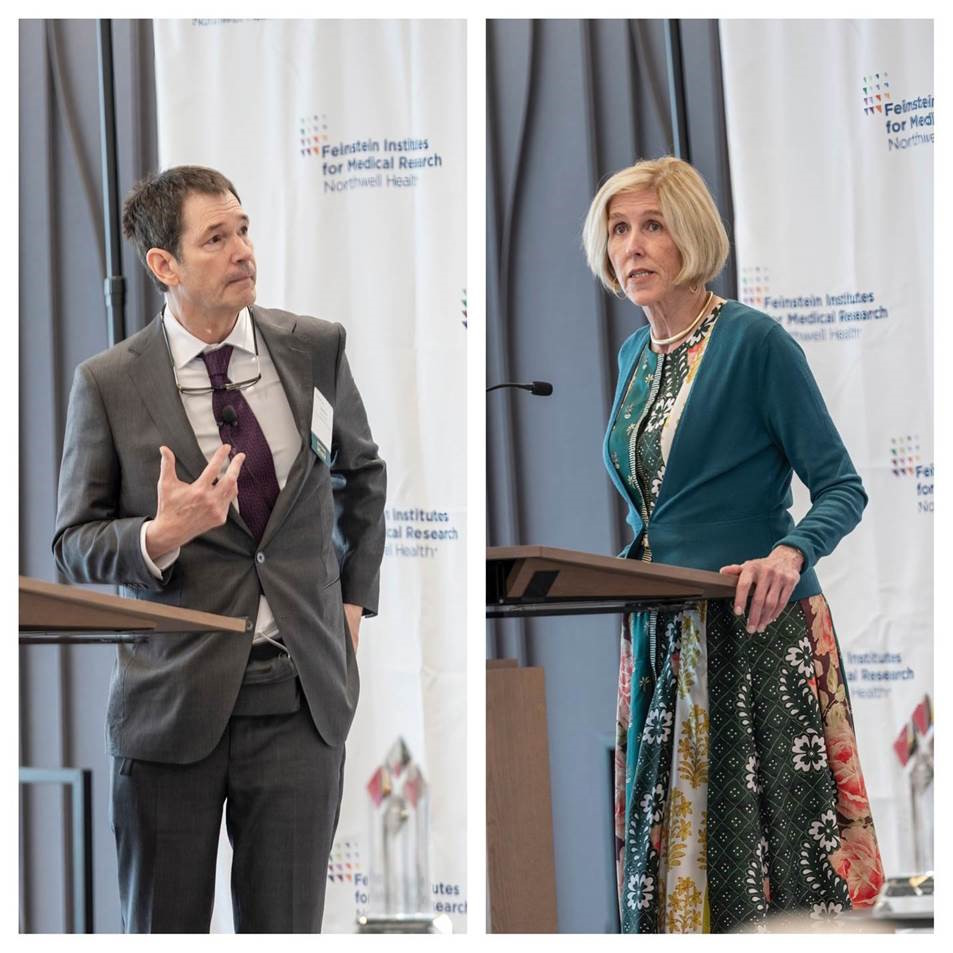Collaboration is Key for 2023 Ross Prize Awardees
Ask Helen Hobbs, M.D. and Jonathan Cohen, Ph.D. about the secret of their research success, and it will come down to one core element: their partnership.

The pair were recently awarded the 2023 Ross Prize in Molecular Medicine by the Feinstein Institutes for Medical Research and the journal Molecular Medicine for their pioneering and collaborative work in defining the genetic risk factors for dyslipidemias and metabolic liver disease that have led to the rational design of new therapies.
Hobbs trained as a physician and a human geneticist, while Cohen trained as a bench scientist and a physiologist. But they also recognize how the different perspectives they bring to their work contributes to its success.
“Helen’s got a very good feel for the big picture in terms of the scientific direction pathway areas to choose and which observations we should follow up…she is far more selectively curious than I am,” says Cohen of their research styles, “(while) I tend to pay attention to experimental details.”
Their complementary differences can also be seen in their personalities, “Helen is ‘s very exuberant and very extroverted, and I tend to be more introverted and certainly more self-contained,” says Cohen.
Hobbs adds, “Jonathan is very easy to work with… he’s got a very level disposition. We both need each other to balance each other out.”
In addition to their strengths both also cite good mentors as pivotal guides in their careers.
“A lot of people want to look for a lab that’s doing the latest technique or, you know, papers in Science and Nature,” says Cohen, “I think having somebody who’s a good first-rate mentor is a number one priority.”
Where it All Started
Cohen was fortunate to connect to Weiland Gevers, chair of biochemistry at the University of Cape Town in South Africa while he was still in high school. A similar relationship with Scott Grundy, head of the Center of Human Nutrition at the University of Texas Southwestern Medical Center, made it possible for Cohen to relocate to Dallas.
There, he soon would meet Hobbs, who moved to UT Southwestern in 1983. A trained physician, she was encouraged by Donald Selden, M.D., head of internal medicine at UT Southwestern to join Nobel Laureates Michael S. Brown and Joseph L Goldstein’s lab whose work in the regulation of cholesterol metabolism, laid the foundation for Hobbs’ own study of the genes that caused severe hypercholesterolemia.
In 1999 Hobbs was asked to help design an epidemiological study for a large grant that scaled from genes to populations. She knew she needed the right partner if she was going to take on the challenge.
“I was used to working with families, not populations,” recalls Hobbs. “I knew immediately if I was going to do this, … that I really needed a partner who had more quantitative skills than I did.”
She started talking to Cohen, and in just six weeks they launched the foundation for the Dallas Heart Study, a large multi-ethnic population study.
“We spent nights up in our labs writing this study, talking to each other, thinking about it, and getting advice from epidemiologists.”
Looking at Gene Variations
While most researchers in the field at the time were operating under the assumption that gene variations found frequently in the population were the cause of common diseases (like hypertension), Cohen and Hobbs took a different approach – they looked for gene variations that were rare but were more likely to cause disease if a person had that variant.
The multi-ethnic nature of the Dallas Heart Study, made up of 50% African-Americans, the most genetically diverse population in Dallas, and including Hispanic and European participants, led them to quickly zero in on mutations in a gene called PCSK9 that were associated with reduced plasma levels of low-density lipoprotein (LDL) cholesterol and decreased risk of heart disease.
This revolutionary discovery meant that new drug development could be targeted at PCSK9 to lower cholesterol levels in patients, and two therapies have since been FDA-approved to do just that. Despite the opportunities such a discovery could yield, the pair are more focused on how their work solves problems, rather than profiting from their foundational work.
“I am really thinking about solving a problem in a lab and answering a question, and the thrill I get is in getting that answer,” says Hobbs.
Doing What They Love
Ultimately, the two are happy to be in a lab doing what they love.
“I like the whole package of being an academic scientist,” says Hobbs. “I love the research, and I like the teaching, the mentoring. There’s just so many aspects of our job that I enjoy, and I just didn’t want to be distracted from them.”
Cohen can’t picture himself as anything other than a scientist, “I can’t imagine…doing anything other than what I do.”
Today, The Hobbs-Cohen Lab continues to use human genetics to identify new therapeutic targets to treat cardiovascular and metabolic disorders and to define key pathways in lipid metabolism. More recently, they discovered the first genetic cause of fatty liver disease in humans. They also continue to employ their dynamic partnership in the way they run their lab.
“There’s always somebody in the lab for the students and post-doctoral fellows to talk with. I think that if you were to talk to the people in our lab, they would see this as a very good thing,” says Hobbs. “But one thing’s always true. Nobody can split us.”
“To have our work recognized by such an honor (as the Ross Prize) is incredibly gratifying, especially for us to be honored together…there’s just no way any of it could have been done without the other,” said Hobbs.
Cohen agrees. “I was just going to say the same thing.”
Read more about the Ross Prize and past awardees:
